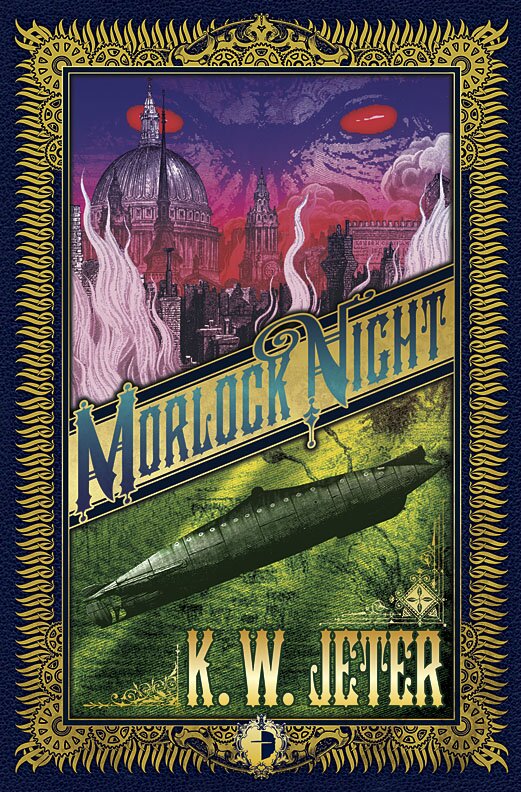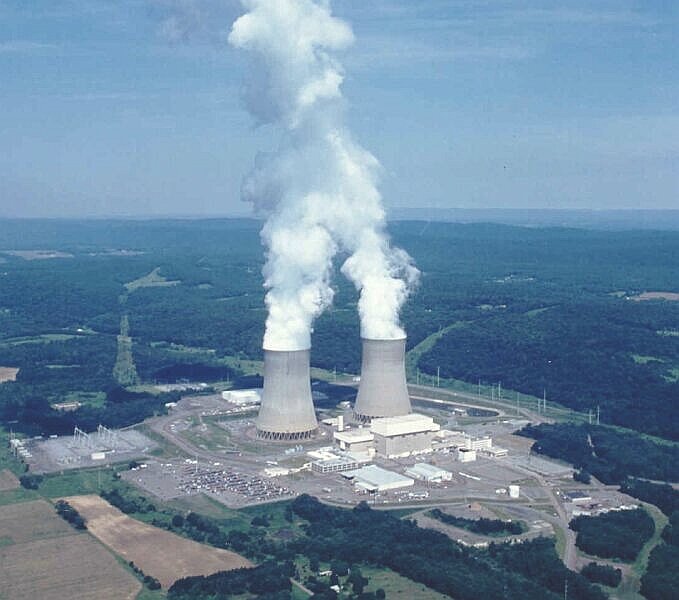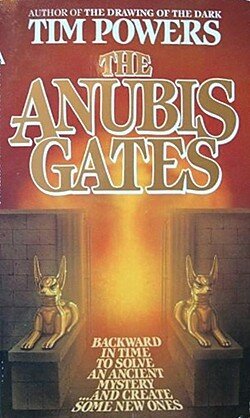Making Steampunk Cool(er) Part Two – What’s in a Name?

Jeter’s 1979 novel (here with a contemporary cover) was a science-fiction/fantasy tale set in a 19th century England threatened by the eponymous creatures from The Time Machine. It was in describing it, along with the work of his colleagues Blaylock and Peters, that Jeter invented the term “Steampunk[s].”
I was delighted at the volume and quality of response to my first article in this series. For all my apparent egotism, I am a surprisingly delicate flower and read the first few comments with one eye closed, dreading the “You sucks!” and the “I hope you dies!” There were a few – delivered both publicly and privately – but for the most part there was only provocative discussion that confirmed some of my beliefs and forced me to rethink others. In short, it was exactly the kind of thoughtful exchange that I hoped this community was capable of. Because it’s the community’s discussion – not just mine – I’ve resisted the temptation to reply to the various comments. However, there was one theme that kept coming up and that I found so interesting that I wanted to discuss it right away – so much so that I’m holding off on the next post I had planned to talk about this first.
What is the significance of the fact that this community is called “Steampunk;” what, in short, is in our name?
Historically, ‘Steampunk” was a word penned light-heartedly by a science fiction novelist referring to the translation of cyberpunk ideas into a 19th century setting. At most it was a loose descriptor of micro-genre elements; alternatively, it was a joke. What it absolutely was not was a well thought out semiotic to represent the boundaries of a sub-culture that organically arose twenty-odd years later. Using its historical origins in that way – insisting that it means said community must be “punk,’ or that it must be based on some arbitrarily defined “Age of Steam” (or that it must not be either those things) is, at best, ill-informed, and at worst willfully disingenuous and self-serving.

Many people use the “Age of Steam” to justify their particular parochial vision for Steampunk as being chained to a certain set of historical tropes. But the very concept of an “Age of Steam” doesn’t hold water (as it were) as most power in 2012 is derived from steam turbines. We may know what people mean when they say the “Age of Steam,” but that’s actually an argument for definition based on community consensus, not logic or history.
For the same reason, arguments about deriving cultural standards from etymological grounds are problematic. The proponents of Steampunk as a sociopolitically neutral movement have performed backflips off of their OEDs in order to explain why the word “punk” is irrelevant to the title and that it’s the “steam” which matters. I have tended to rejoin this argument by pointing out that the overwhelming majority of the electricity today is generated in steam turbines (even nuclear reactors generate usable power in sophisticated steam engines) – and thus that if one really wants to insist that what matters is the “Age of Steam” business then our temporal boundaries should extend up to 2012. This usually provokes someone to point out that the “Age of Steam” refers to motive power and locomotives, or the shift in the latter half of the 19th century from wind-powered shipping vessels to coal driven steam engines . . . or any of a dozen other arguments of varying legitimacy justifying some particular set of years as such an Age.

The hilarious problem with basing the “definition” of Steampunk upon the perceived meaning of its constituent nouns is that one ends up excluding things like Anubis Gates – which is basically a fantasy novel. I’ve had Steampunk “experts” tell me with a straight face that this book isn’t Steampunk based on its era and its content, despite the fact that the very man who invented the word referenced it in his original letter on the topic. It’s fine for them to believe that – Steampunk is just a word and the Steampunk community is just that, a community, and we can redefine both as we see fit. But we can’t both have that dynamism AND the authority of a definition based on some external authority. Steampunk is nothing more, or less, than what we decided to make it.
Which brings us back to the larger point – Steampunk is just a word. It allows us to define a thing, but it doesn’t mean that Steampunk itself has an external reality the way that an elephant or a streetcorner does. Steampunk is only a thing insofar as we all sort of kind of agree that we generally have a sense of it when we see it most of the time.
People have called me out for telling people that they can’t make up rules about what Steampunk is and is not – and that this is my own form of tyranny and “fun-ending.” But I don’t have any trouble with people making up their own definitions of Steampunk – I’d be lying if I said that I didn’t have a sense of it in my own head. My objection is to anyone telling anyone else that their definition of a made-up word is any better than any other definition.
The only Steampunk experts (myself absolutely included) are self-appointed ones and everyone’s opinion is pretty much as good as everyone else’s. We are the only arbiters of our own culture and community. We will determine what it does and does not stand for. If some of us want to dogmatically adhere to the notion that the only “true” Steampunk involves Mohawks in an alternate 1860 because that’s how we interpret the name, fine. But there is no reason beyond completely amorphous community standards that we can’t use that name to apply to whatever we want it to.
To the extent that the name, the word, Steampunk, frees us to be creative, to be happy, and to inhabit a better world – I think that we should embrace it. When the name itself becomes divisive and an excuse to wage petty battles over authority, it’s time to step back and remember that Republicans used to proudly define themselves as belonging to the party of Lincoln. Steampunk is going to change and evolve and come to mean different and new things (just like Goth has) unless the people who insist that Steampunk must mean “X” and that anything which isn’t “X” must be excluded (continue to) dominate the community.
In that case, all the things that Steampunk could become will continue to happen – they’ll just go by a different name.
![Morlock Night Jeter's 1979 novel (here with a contemporary cover) was a science-fiction/fantasy tale set in 19th century England threatened by the eponymous creatures from The Time Machine. It was in describing it, along with the work of his colleagues Blaylock and Peters, that Jeter invented the term "Steampunk[s]."](/wp-content/uploads/2012/06/morlocknight-521x420.jpg)

I’ve had people dogmatically tell me that Firefly wasn’t steampunk because it was set in space; it was a space western. My answer is “why can’t it be both?” It mixes tropes and styles from the 1800′s with futuristic tropes – isn’t that basically the same thing steampunk does? Simon Tam’s upper-class suits, Mal’s Browncoat look and Kaylee’s wrench-wench attire certainly fit will with the steampunk aesthetic and enrich it; why should they be excluded? And if you see a girl in a ruffled hoopskirt dress, are you going to ask, “Is that a PERIOD-inspired dress or a FIREFLY-inspired dress”? That’s just silliness.
I am glad to read this piece about the trickiness of defining current movements, because that is what I think this piece is about in the core of its meaning, if I read it correctly. I like the solution that you came up with, that anyone’s idea of what steampunk is is correct as long as it doesn’t infringe upon another person’s perception of the word. I used to be confused by the names of various cultural movements because they never seem to have a consensus based definition. Now it seems to me that if a movement has a definition to accompany its name it means that the movement is dead and no longer growing and changing. Personally, I think that naming movements into little boxes is a confusing waste of time and a silly endeavor, because in the end the name does not matter at all. Thanks for writing!
I whole heartedly agree with you position that everyone’s definition of steampunk is equally valid and I too have had conflicts with folks trying to set in stone their definition and therefor position themselves as the “absolute authorities” of steampunk. This goes beyond aesthetics and includes cultural values and the appropriateness of displaying factual early 20th historical century elements in steampunk depictions.
I PREFER my steampunk to carry elements of the Victorian and Rooseveltian eras. I also have no interest in a utopian emphasis or attempt to impose contemporary thinking and values on a fictional historical people in an attempt to right historical wrongs (yes, I agree there were alot of wrongs in this age too).
HOWEVER…I agree that if that is someone else’s focus for their interpretation of steampunk…by all means have at it.
I grew up during the punk invasion of the US…and I get a little touchy when someone not even alive at the time tries to tell me what the punk culture was all about (especially here in the US-You from Jersey cause I friggin am! I threw-up in more punk clubs in the late seventies and early eighties… )
So the name is the same issue- some folks quote the original roots to cyberpunk while others wave the band of social change and a utopian goal of a better today based on a fictional utopian yesterday.
I’ll stick to my neo-colonialism and mocking portrayal of all the flaws of ALL the cultures of the early 20th century…with airships…and goggles…there must be goggles!
As exciting as it is when you find someone who is just discovering steampunk, I always dread the inevitable ‘but what IS steampunk?’ question. I always describe it by saying you can ask 5 people what steampunk means and get 7 different answers, but just to get a ‘feel’ for the genre and the tropes and make it your own. Some people see it purely as a style of literature, music or art. Some see it just as a fashion choice. Others see it as a lifestyle, and some treat it somewhat like LARP. Many people have a mix of all these aspects, and that is what makes socialising with steampunks and being part of the community so interesting!